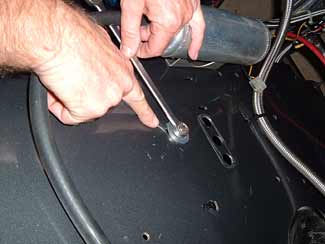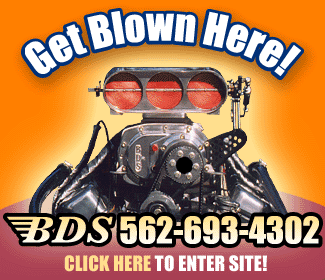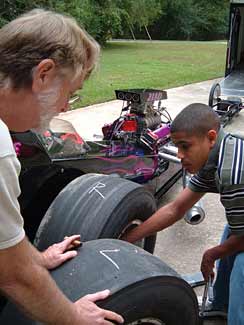|

 “For
the front, we run what the manufacturer recommends, from
32 to 35 to 40 pounds. We usually go 32 pounds, because it
gives the car a better feel when steering. We’ll go
to 35 or 40 if we’re trying to go fast.” “For
the front, we run what the manufacturer recommends, from
32 to 35 to 40 pounds. We usually go 32 pounds, because it
gives the car a better feel when steering. We’ll go
to 35 or 40 if we’re trying to go fast.”
  “This
relates to the dragsters. If somebody buys a used dragster,
they need to contact the builder, to find out the idiosyncrasies
of the car. The builder should then be able to give them
a build sheet or information as far as towing and transportation.
The biggest thing we run into is the blow shield, behind
the driver. Where it should have been barely loose, somebody
will come along and tighten it up and that ties the center
of the car down. Our cars are designed to flex at the blow
shield, so the blow shield is slotted on the top and there’s
a fly washer on either side of the slot with a lock nut.
You just tighten the nut down until you can just spin the
washer. That will allow the car to work and flex. And that’s
what people need to find out --- any pertinent information
like that, to make the car work or how to transport it, go
back to the guy who built the car. Little things like that
make the difference between performance and the longevity
of the chassis.” “This
relates to the dragsters. If somebody buys a used dragster,
they need to contact the builder, to find out the idiosyncrasies
of the car. The builder should then be able to give them
a build sheet or information as far as towing and transportation.
The biggest thing we run into is the blow shield, behind
the driver. Where it should have been barely loose, somebody
will come along and tighten it up and that ties the center
of the car down. Our cars are designed to flex at the blow
shield, so the blow shield is slotted on the top and there’s
a fly washer on either side of the slot with a lock nut.
You just tighten the nut down until you can just spin the
washer. That will allow the car to work and flex. And that’s
what people need to find out --- any pertinent information
like that, to make the car work or how to transport it, go
back to the guy who built the car. Little things like that
make the difference between performance and the longevity
of the chassis.”
 “We
don’t recommend a rubber nut for towing. We prefer
to actually fabricate a wooden block with a piece of carpet
on top, cut to a certain height. This primarily concerns “We
don’t recommend a rubber nut for towing. We prefer
to actually fabricate a wooden block with a piece of carpet
on top, cut to a certain height. This primarily concerns
ADVERTISEMENT
 |
|
hard-tail cars. We put our rear tires at the towing pressure,
then we measure the distance from the trailer floor to where
you’re going to block it, build a piece of wood with
carpet covering on it an eighth- to a quarter-inch taller
than that dimension. Jack the car up, slide it under and
the car should bow in the opposite direction, so the tire
should still touch the floor on both ends. If they don’t
touch the ground, then you need to trim some more off the
board until they do. You also need to have a guide for the
front tires, something to keep the tires from turning, because
if the tires turn, it changes the height of the chassis,
which changes your wood block.”
  “Should
you tow in park or neutral? We do both. It just depends on
the car and the transmission. There is no rule. If there
is a problem, the transmission people should tell you, but
if we can get to the inside of the car, we put it in park.
That’s just one more piece of safety. With a stick
shift car, you have to tow it in neutral.” “Should
you tow in park or neutral? We do both. It just depends on
the car and the transmission. There is no rule. If there
is a problem, the transmission people should tell you, but
if we can get to the inside of the car, we put it in park.
That’s just one more piece of safety. With a stick
shift car, you have to tow it in neutral.”
 “We
also rotate the rear tires on a regular basis. How regular?
Bracket cars, once a week, faster cars, every run. It keeps
the life in the tire longer, plus it keeps it from taking
a set. Take the car out, jack it up, switch the wheels and
go. The faster the car, the more often we do it.” “We
also rotate the rear tires on a regular basis. How regular?
Bracket cars, once a week, faster cars, every run. It keeps
the life in the tire longer, plus it keeps it from taking
a set. Take the car out, jack it up, switch the wheels and
go. The faster the car, the more often we do it.”

|
